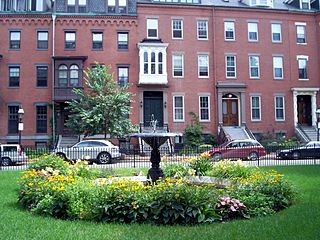
The South End is a neighborhood in Boston, Massachusetts, United States which is bordered by Back Bay, Chinatown, and Roxbury. It is distinguished from other neighborhoods by its Victorian-style houses and the parks in and around the area. The South End is the largest intact Victorian row-house district in the country, covering over 300 acres (120 ha). It has eleven residential parks. In 1973, the South End was listed on the National Register of Historic Places. Much of the neighborhood was originally marshlands in Boston's South Bay. After it was filled in, construction began in 1849.
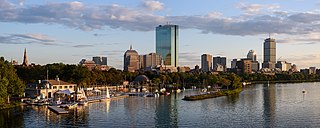
Back Bay is an officially recognized neighborhood of Boston, Massachusetts, built on reclaimed land in the Charles River basin. Construction began in 1859, as the demand for luxury housing exceeded the availability in the city at the time, and the area was fully built by around 1900. It is most famous for its rows of Victorian brownstone homes—considered one of the best preserved examples of 19th-century urban design in the United States—as well as numerous architecturally significant individual buildings, and cultural institutions such as the Boston Public Library, and Boston Architectural College. Initially conceived as a residential-only area, commercial buildings were permitted from around 1890, and Back Bay now features many office buildings, including the John Hancock Tower, Boston's tallest skyscraper. It is also considered a fashionable shopping destination and home to several major hotels.

Beacon Hill is a historic neighborhood in Boston, Massachusetts, United States, and the hill upon which the Massachusetts State House resides. The term "Beacon Hill" is used locally as a metonym to refer to the state government or the legislature itself, much like Washington, D.C.'s Capitol Hill does at the federal level.

The Public Garden, also known as Boston Public Garden, is a large park in the heart of Boston, Massachusetts, adjacent to Boston Common. It is a part of the Emerald Necklace system of parks and is bounded by Charles Street and Boston Common to the east, Beacon Street and Beacon Hill to the north, Arlington Street and Back Bay to the west, and Boylston Street to the south. The Public Garden was the first public botanical garden in America.
There are three houses named the Harrison Gray Otis House in Boston, Massachusetts. All were built by noted American architect Charles Bulfinch for the same man, Federalist lawyer and politician Harrison Gray Otis.

Bay Village is the smallest officially recognized neighborhood of Boston, Massachusetts, United States. As of 2010, its population was approximately 1,312 residents living in 837 housing units, most of which are small brick rowhouses.

Central Square is a section of the neighborhood of East Boston in Boston, Massachusetts, United States. The square begins at the intersection of Bennington Street and Meridian Street, continues up Meridian to its intersection with White Street, and includes all the area to the left. The square's intersecting streets also include Border, Saratoga, and Eutaw Street. It is within close proximity of the entrance to the Sumner Tunnel, which motorists take to downtown Boston.

Tremont Street is a major thoroughfare in Boston, Massachusetts.

Charles Street is the name of a north-south street in the city center of Boston, Massachusetts. It begins in the north at Leverett Circle, where it connects with Nashua Street and Monsignor O'Brien Highway. Science Park station on the MBTA Green Line is located there. Charles Street runs south and gives its name to the Charles/MGH station on the MBTA Red Line, connecting via the Charles Circle rotary to Cambridge Street and the Longfellow Bridge which leads to Cambridge. This segment is a one-way street, with traffic heading northwards.
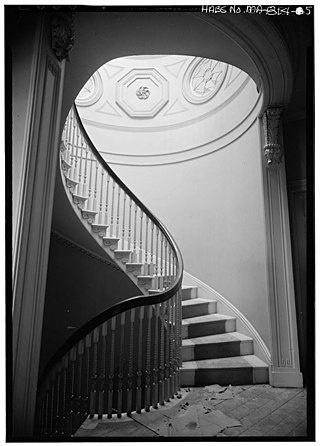
The Nathan Appleton Residence, also known as the Appleton-Parker House, is a historic house located at 39–40 Beacon Street in the Beacon Hill neighborhood of Boston, Massachusetts. It was designated a National Historic Landmark for its association with revolutionary textile manufacturer Nathan Appleton (1779–1861), and as the site in 1843 of the wedding of his daughter Frances and poet Henry Wadsworth Longfellow. The house is an excellent early 19th century design of Alexander Parris.
Mount Vernon Proprietors was a real estate development syndicate operating in Boston, Massachusetts. Founded at the end of the 18th century, it developed land on the south slope of Beacon Hill into a desirable residential neighborhood.
Chester Square is a residential garden square located along Massachusetts Avenue in Boston, between Tremont Street and Shawmut Avenue. The name "Chester" is derived from the original name of the street, which was renamed Massachusetts Avenue on March 1, 1894. Chester Park is also located in the historic South End of Boston.

William Hickling Prescott House, also known as the Headquarters House, is an historic house museum located at 55 Beacon Street on Beacon Hill in Boston, Massachusetts. It is the left-hand portion of a double townhouse at 54–55 Beacon Street, seen in the photograph. The townhouse, built in 1808 to a design by Asher Benjamin, was designated a National Historic Landmark in 1964 for its association with William Hickling Prescott (1796–1859), one of the nation's first historians. The house is now a museum operated by the Massachusetts chapter of the National Society of the Colonial Dames of America, which purchased it for its headquarters in 1944.
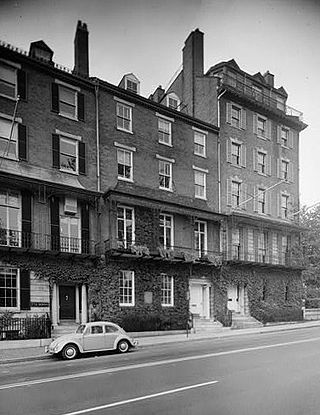
Cornelius Coolidge was a real estate developer in early 19th-century Boston, Massachusetts, who constructed buildings in Boston's Beacon Hill neighborhood, and elsewhere. As a young man he had been involved in maritime trade, but not always within the prescribed laws. During the War of 1812, the brig Dispatch owned by Coolidge and Francis Oliver was captured outside Boston Harbor by the Salem privateer Castigator on suspicion of trading with the enemy. Coolidge and Oliver operated two boats with 45 armed men, rowed down the harbor, and regained their brig after an exchange of gunfire. However, the district court restored the brig to the privateers.
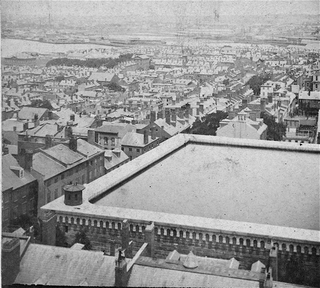
The Beacon Hill Reservoir in Boston, Massachusetts provided water to Beacon Hill from Lake Cochituate. It could hold 2.6 million US gallons (9,800 m3). By 1876, the reservoir no longer distributed water, but rather functioned as a storage facility; it was dismantled in the early 1880s.

Mount Vernon Church in Boston, Massachusetts, was a Congregational church located on Beacon Hill (1844–1891) and later in Back Bay (1892–present).

Mount Vernon Triangle is a neighborhood and community improvement district in the northwest quadrant of Washington, D.C. The neighborhood is located adjacent to Mount Vernon Square. Originally a working-class neighborhood established in the 19th century, present-day Mount Vernon Triangle experienced a decline in the mid-20th century as it transitioned from residential to commercial and industrial use.

A statue of Christopher Columbus is installed in Boston's Beacon Hill neighborhood, within Louisburg Square, in the U.S. state of Massachusetts. A Greek merchant, Joseph Iasigi, presented the statue to the city in December 1849. A captain of one of his vessels had loaded it onto a ship in Italy as ballast, alongside a statue of Aristides which was also donated. Both statues are described as "inferior" and "unremarkable" by art critics. The Italian marble sculpture was carved in Leghorn and depicts Columbus as a boy.
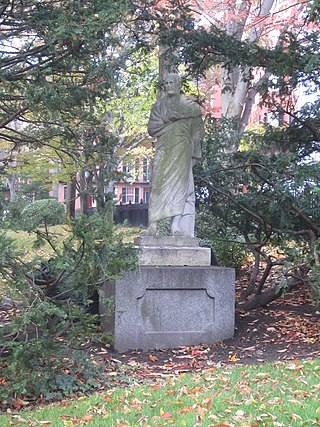
A statue of Aristides is installed in Boston's Beacon Hill neighborhood, within Louisburg Square, in the U.S. state of Massachusetts. The 6-foot (1.8 m) sculpture was imported from Italy in 1834 by Joseph Iasigi, then Turkish consul, who lived at 3 Louisburg Sq. When the other proprietors of the Square were reluctant to accept the statue, he sweetened his offer with a statue of Christopher Columbus for the north end of its park.



















